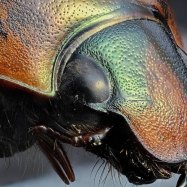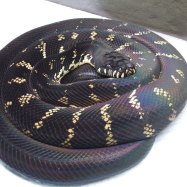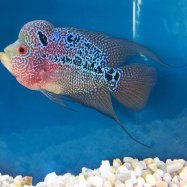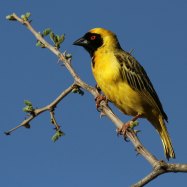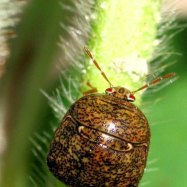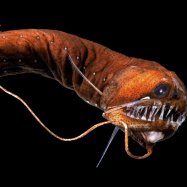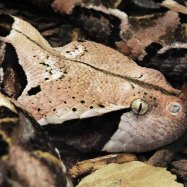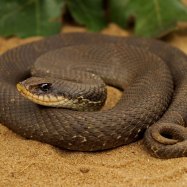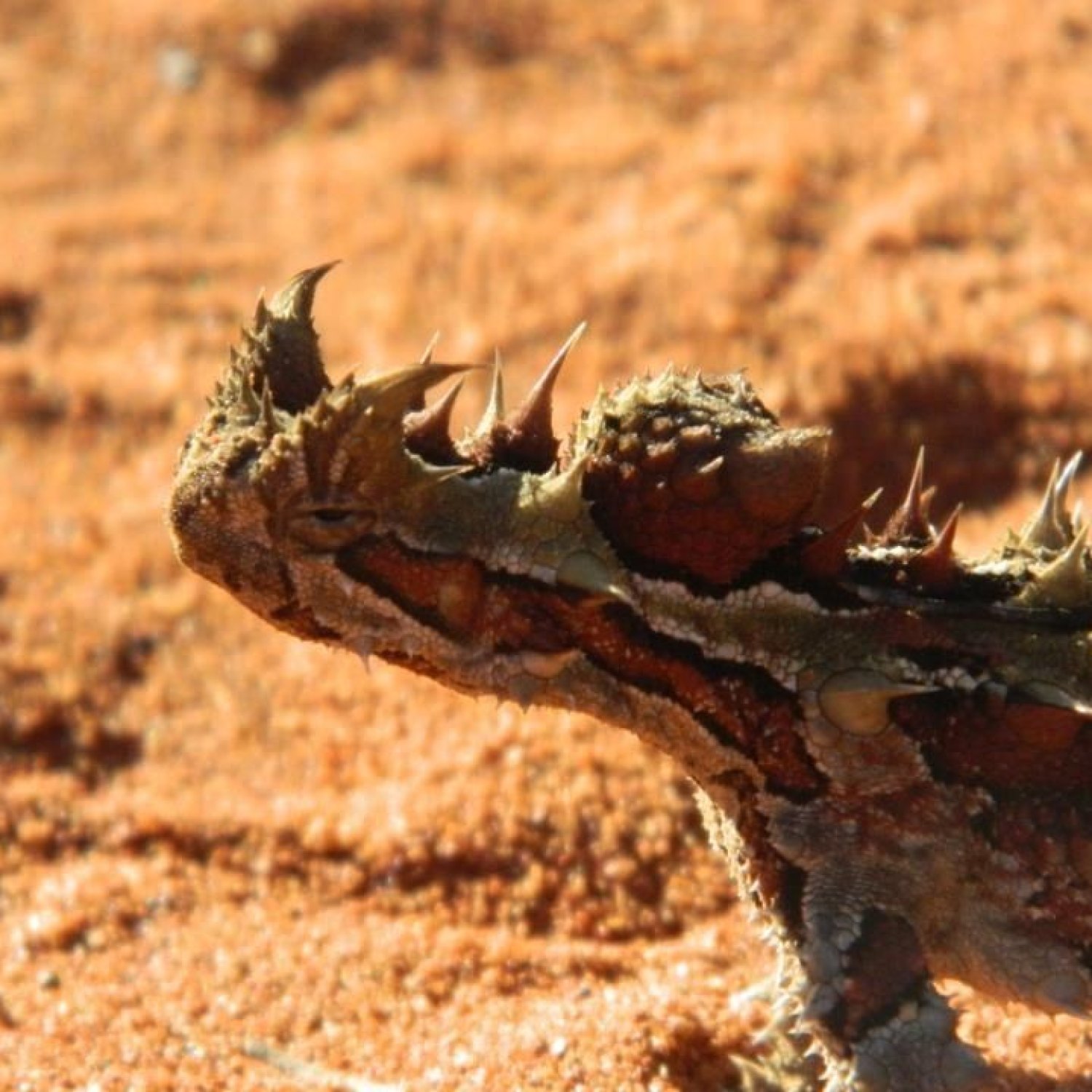
Thorny Devil
Up to 20 cm (7.9 in)
The Thorny Devil, also known as Moloch horridus, is a unique lizard found in Central Australia. It can grow up to 20 cm and has a dorsally flattened body covered in thorny spines. Its family name is Agamidae and it has a distinctive defense mechanism where it can change color to blend in with its surroundings. This fascinating creature is a must-see for nature lovers. #ThornyDevil #CentralAustralia #Agamidae #MolochHorridus #Lizard
Animal Details Summary:
Common Name: Thorny Devil
Kingdom: Animalia
Habitat: Desert and arid scrubland
The Unique and Mysterious Thorny Devil: A Creature of the Australian Outback
The Australian outback is known for its vast and diverse array of wildlife, from kangaroos to koalas, but there is one creature that stands out amongst the rest – the Thorny Devil. With its distinctive appearance and mysterious nature, the Thorny Devil has captured the attention of both scientists and tourists alike.Scientifically known as Moloch horridus, this reptile goes by many other names, such as the Thorny Devil, Thorny Dragon, or Moloch. Regardless of its name, this little creature is a true marvel of nature and is unlike any other animal in the world Thorny Devil. In this article, we will delve into the fascinating world of the Thorny Devil and discover what makes it such a unique and enigmatic creature.
The Kingdom of the Thorny Devil
Like all living organisms on Earth, the Thorny Devil belongs to a specific classification in the animal kingdom. It belongs to the kingdom Animalia, meaning that it is an animal with eukaryotic cells, multicellular organisms, and the ability to move and eat. These characteristics set it apart from plants and other non-animal life forms.Phylum and Class: Characteristics of a Reptile
The Thorny Devil is a member of the phylum Chordata, which includes all animals with a spinal cord or backbone. This puts it in the same category as other reptiles, mammals, fish, and birds. However, it belongs to a specific class – Reptilia, which is composed of animals that are cold-blooded, have scaly skin, and lay eggs. This includes snakes, lizards, and turtles.Order and Family: The Squamata Connection
The Thorny Devil is part of the order Squamata, which is a subcategory of the class Reptilia Thai Ridgeback. This order is comprised of animals with scaly skin, a characteristic that is shared by all reptiles. Within the order Squamata, the Thorny Devil belongs to the family Agamidae, which includes more than 430 species of lizards commonly known as agamids or dragon lizards.The Thorny Devil's Habitat and Feeding Habits
The Thorny Devil is native to the desert and arid scrubland of central Australia, which means that it is well-adapted to harsh and dry environments. This reptile is known for its unique feeding method, which is insectivorous. This means that it feeds primarily on insects such as ants, termites, and beetles. Interestingly, the Thorny Devil has a specialized tongue that helps it catch its prey. The tongue is covered in a sticky substance that allows it to capture insects with ease.The Geographical Distribution and Country of Origin of the Thorny Devil
As mentioned earlier, the Thorny Devil is found in the central region of Australia. This covers areas such as Western Australia, South Australia, and the Northern Territory. Its distribution is limited to these areas, making it a unique and endemic species. As a testament to its origins, the Thorny Devil is also the official animal emblem of the state of Western Australia.The Thorny Devil's Appearance
One cannot talk about the Thorny Devil without mentioning its unique and striking appearance. This reptile is easily identified by its dark brown coloration and distinctive yellowish or orange markings. It has a flattened body, with rough, ridged skin covered in thorny spines. These spines act as a form of protection against predators, as well as help the Thorny Devil blend in with its environment.Size Matters: How Big is the Thorny Devil?
The Thorny Devil may look small, but it can actually reach up to 20 cm (7.9 in) in length. This makes it one of the largest species of dragon lizards in Australia. Its size, combined with its unique features, makes it an impressive and fascinating creature to observe in its natural habitat.A Closer Look at the Thorny Devil's Behavior
While the Thorny Devil's appearance alone is enough to make it stand out, its behavior is equally intriguing. This reptile has several unique and adaptive behaviors that have helped it survive in the harsh conditions of the Australian outback.One of its most impressive behaviors is its ability to change color. Depending on the temperature and the color of the soil it is on, the Thorny Devil can change its coloration to better blend in with its surroundings. This is due to specialized cells in its skin that control the distribution of pigments.
Another interesting behavior of the Thorny Devil is its ability to collect water through its skin. In the dry and arid regions it inhabits, water is a scarce resource, so the Thorny Devil has evolved to absorb moisture from its surroundings. It does this by flattening its body and collecting dew or rainwater on its skin, which is then absorbed into its mouth.
The Future of the Thorny Devil in the Modern World
With its unique appearance and behavior, the Thorny Devil has captured the attention of scientists and animal lovers around the world. Unfortunately, due to habitat loss and other environmental factors, this species is considered vulnerable. Efforts are being made to conserve the Thorny Devil and ensure its survival for future generations to appreciate and admire.The Thorny Devil: A Natural Wonder
In conclusion, the Thorny Devil is a truly unique and remarkable creature, perfectly adapted to its environment in central Australia. With its striking appearance, clever behaviors, and important role in the ecosystem, the Thorny Devil is a natural wonder that deserves to be protected and celebrated. As we continue to learn more about this mysterious reptile, we can only hope that it will continue to thrive and enchant us with its beauty and resilience. So, if you ever find yourself in the Australian outback, keep your eyes open – you never know when you might catch a glimpse of the legendary Thorny Devil.

Thorny Devil
Animal Details Thorny Devil - Scientific Name: Moloch horridus
- Category: Animals T
- Scientific Name: Moloch horridus
- Common Name: Thorny Devil
- Kingdom: Animalia
- Phylum: Chordata
- Class: Reptilia
- Order: Squamata
- Family: Agamidae
- Habitat: Desert and arid scrubland
- Feeding Method: Insectivorous
- Geographical Distribution: Central Australia
- Country of Origin: Australia
- Location: Central Australia
- Animal Coloration: Dark brown with yellowish or orange markings
- Body Shape: Dorsally flattened and covered in thorny spines
- Length: Up to 20 cm (7.9 in)

Thorny Devil
- Adult Size: Up to 20 cm (7.9 in)
- Average Lifespan: 8-12 years
- Reproduction: Sexual
- Reproductive Behavior: Males fight over females, females lay eggs
- Sound or Call: Grunt when threatened
- Migration Pattern: Non-migratory
- Social Groups: Solitary
- Behavior: Slow-moving and docile
- Threats: Habitat loss, predation
- Conservation Status: Least Concern
- Impact on Ecosystem: Helps control insect populations
- Human Use: No significant human use
- Distinctive Features: Thorny spines on body, spiky appearance
- Interesting Facts: Can drink water through capillary action on its skin
- Predator: Birds of prey, snakes
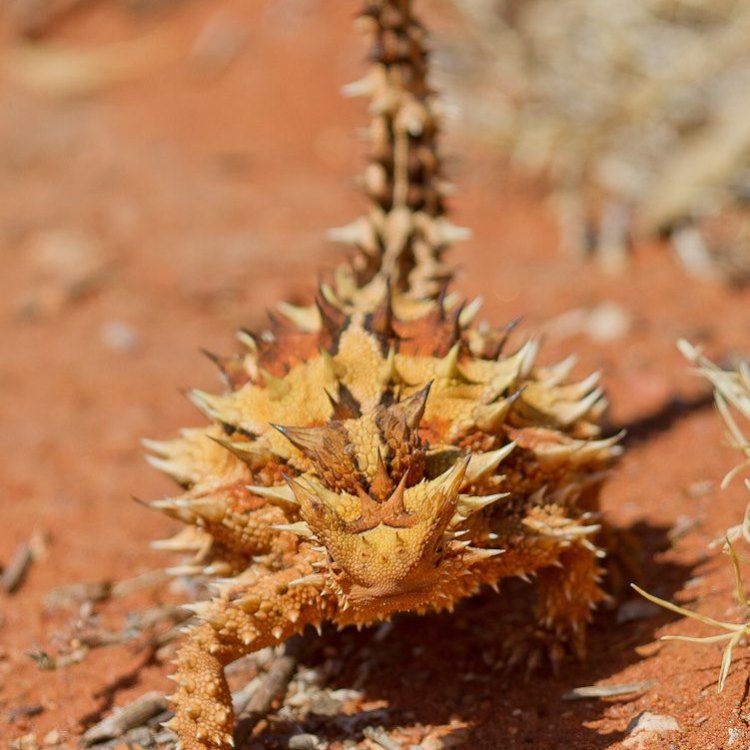
Moloch horridus
The Fascinating World of the Thorny Devil
Deep in the arid desert regions of central and western Australia, a seemingly unassuming creature roams the rugged terrain. Its appearance may not be striking at first glance, but upon closer inspection, one cannot help but be drawn to its unique and fascinating features. This creature is none other than the thorny devil.Known scientifically as Moloch horridus, the thorny devil is a small reptile belonging to the family Agamidae PeaceOfAnimals.Com. It is the sole member of the genus Moloch and is commonly referred to as the "mountain devil" or "thorny dragon." Despite its intimidating monikers, this harmless creature is a valuable member of its ecosystem and has captured the fascination of many with its intriguing characteristics.
The adult size of the thorny devil can reach up to 20 cm (7.9 in) in length, making it a relatively small lizard. However, what it lacks in size, it more than makes up for in its distinctive physical appearance. The most striking feature of this creature is its thorny spines that cover its entire body. These spines give the thorny devil its characteristic spiky appearance and serve as a form of defense against predators.
The thorny devil's average lifespan is 8-12 years, making it a long-lived creature in the reptile world. It is a slow-growing species, taking up to five years to reach sexual maturity Tufted Coquette. Once mature, it reproduces sexually, with males vying for the attention of females during the breeding season. This involves intense territorial battles between males, with the winner getting to mate with the female. The female then lays her eggs in a shallow burrow, and they hatch after several months.
When threatened, the thorny devil is known to emit a defense mechanism by grunting. This sound is meant to startle predators and give the thorny devil a chance to escape to safety. However, despite its spikes and noises, the thorny devil is a solitary creature and does not form social groups. It spends most of its time alone, slowly moving through its desert habitat in search of food.
The thorny devil is a non-migratory species, meaning it does not travel long distances seasonally. It is well adapted to its arid environment, and it can withstand extreme temperatures and dehydration. This resilience is thanks to its unique ability to drink water through its skin through capillary action. The thorny devil collects the tiny droplets of water that condense on its body during the cool desert nights and channels them to its mouth. This remarkable adaptation allows the thorny devil to survive in some of the harshest regions of the world.
Despite its spiky exterior, this reptile is docile and poses no significant threat to humans. In fact, the thorny devil has no significant use to humans, and it holds no special cultural or economic importance. However, it does play a vital role in its ecosystem, contributing to the balance of its fragile environment.
One of the most notable ways in which the thorny devil benefits its ecosystem is by helping control insect populations. As an insectivore, it feeds on a wide variety of insects, including ants and termites. In areas where these insects may become pests, the thorny devil plays a crucial role in keeping their populations in check, preventing potential damage to crops and other plants.
However, as with many species, the thorny devil is facing threats that could potentially impact its population. The main threat to this species is habitat loss. As human development encroaches upon their desert homes, the thorny devil's habitat is shrinking, leaving them with less space to roam and forage for food. Additionally, introduced predators, such as feral cats and foxes, pose a significant risk to the thorny devil's survival.
Despite these threats, the thorny devil's conservation status is currently listed as "Least Concern" on the IUCN Red List. This is due to its widespread distribution and relatively stable population. Protection of its natural habitat, as well as laws and regulations in place to prevent the trade and exploitation of this species, has helped to maintain its population.
Beyond its role in its ecosystem and its intriguing features, the thorny devil also has some interesting facts that make it stand out among its reptilian counterparts. For example, it has a unique adaptation to blend in with its surroundings, known as crypsis. The thorny devil's spines are not just for protection; they also help it camouflage with the desert sand and rocks. It even has a false head at the back of its neck, complete with spines, to confuse predators.
The thorny devil's spines and crypsis have even inspired designs for armor and camouflage in military and technological fields. The US Army has studied the thorny devil's skin for potential use in developing body armor, while the University of Queensland is using its camouflage abilities to design anti-reflection coatings for solar panels.
Unfortunately, despite its adaptation and unique features, the thorny devil does have predators in its natural environment. Birds of prey and snakes are some of the natural predators of this species. They use their sharp vision and keen sense of smell to locate the thorny devil, making it a constant target in the harsh desert landscape.
In conclusion, the thorny devil may be a small and solitary creature, but it has captured the imagination of many with its fascinating features and remarkable adaptations. Its spiky appearance, ability to drink through its skin, and role in controlling insect populations make it a valuable member of its ecosystem. And while it poses no threat to humans, it is a vital part of the delicate balance of the Australian desert. The thorny devil serves as a reminder of the wonders and diversity of the natural world and the importance of protecting it for future generations.
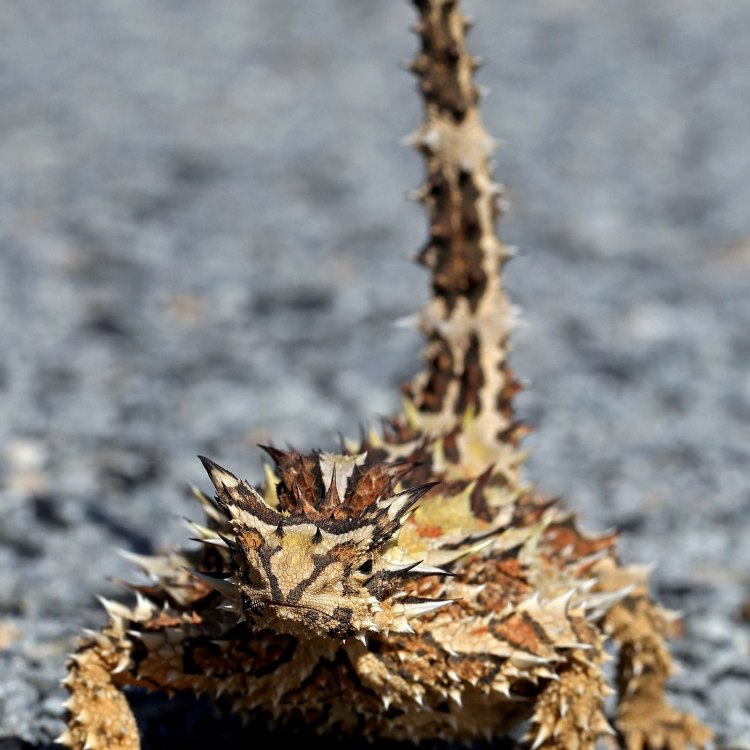
The Unique and Mysterious Thorny Devil: A Creature of the Australian Outback
Disclaimer: The content provided is for informational purposes only. We cannot guarantee the accuracy of the information on this page 100%. All information provided here may change without prior notice.

